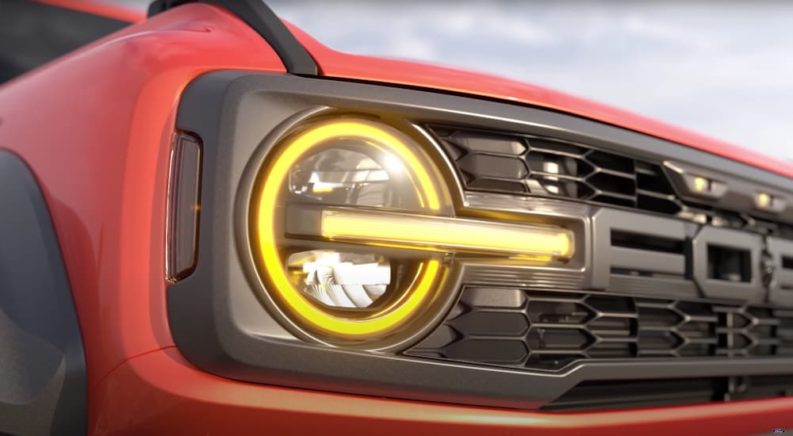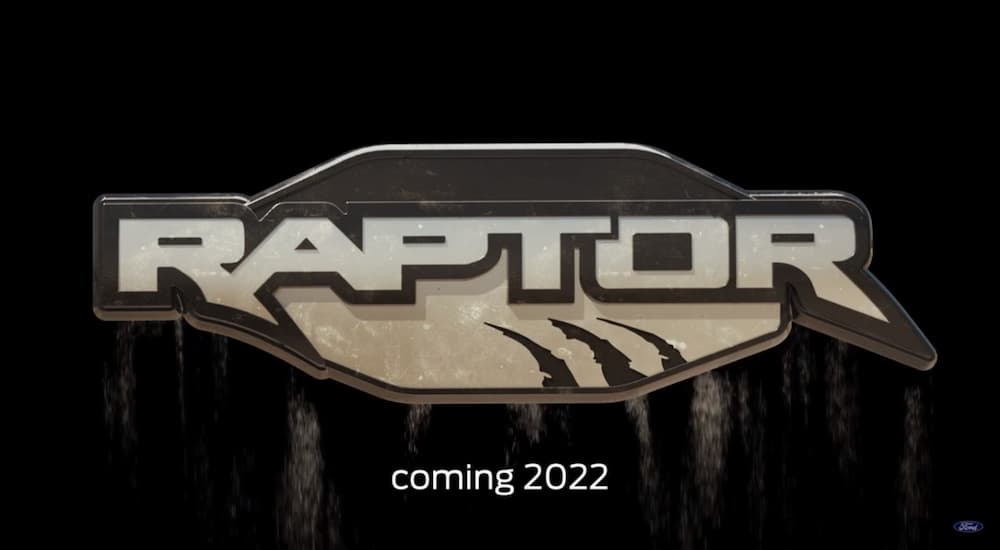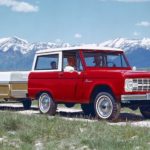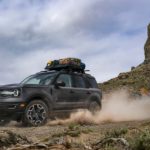The Baja 1000 is the Ironman race of the gas-powered world. Much like that other feat of human endurance, you don’t have to be crazy to undertake it, but it helps. Coursing through miles of sand, rocks, and gravel in the notoriously harsh environment of Mexico’s Baja California Peninsula, teams of two spend between 20 and 25 hours traversing the course. While nominally a 1000-mile race, past Baja races have ranged anywhere between 800 and 1200 miles: a grueling marathon that’s bound to trip up all but the heartiest drivers and vehicles. While the race is open to a wide swath of vehicles, this isn’t a race for your average sedan. It takes a special type of vehicle to survive the ordeal, with spots on the podium reserved for only the most rugged, well-built vehicles around.
Ford has been involved in the world-famous desert race almost since its inception, with the Ford Bronco making history as the first production 4×4 ever to win the race back in 1968. The recently revived Bronco is living up to its predecessor’s reputation, completing the 2020 Baja 1000 in its first year on the market, and now a new performance-minded version of the popular SUV is ready to take up the mantle. The 2023 Ford Bronco Raptor combines the Bronco’s off-road heritage with the high-performance bona fides of Ford’s high-performance Raptor pickups, creating a brawny 4×4 ready-made to tackle the grueling desert challenge. While the new model has yet to hit the market, it’s never too early to start preparing for your own off-road adventures. While we wait for its debut, let’s pass some time looking at the history of the Baja 1000, the Bronco’s role in the famous race, and a few reasons why you should reserve a Ford Bronco Raptor.
A Race Unlike Any Other
Competitors spend up to two weeks preparing for the race itself, traversing the course to familiarize themselves with the terrain, conditions, and any pitfalls that might be hard to spot when tearing through the desert at 80 mph. From rocky mountain passes to vast arid deserts, the harsh landscape is working overtime to stymie racer’s ambitions, throwing off enough heat, grit, and dry desert air to test even the heartiest 4×4. It’s the Baja’s fine grain sand that’s often the racer’s biggest foe, decimating traction and visibility while sticking to every surface it encounters. This silt is described by some races as being as fine as talcum powder, with the microscopic grains almost behaving more like a liquid at times.
“You get almost no real traction on it, so it’s just a momentum game to get through it because you’re just plowing through it almost like a liquid, like water. If you stop, you are going to get stuck in it,” said Baja 1000 participant Jason Torchinsky in an interview with Business Insider. As if the course itself wasn’t challenging enough, locals have made a pastime of making the secluded route even more treacherous. Booby traps have long been a part of the Baja experience; from mud pits and hidden jumps to holes and random debris, there are always a few surprises along the way you’ll never find on the official map. While these might seem like malicious contributions from the crowd, they’re not actually meant to cause accidents, just provide a little excitement or viral content for spectators who have been camping out all day for a few moments of action.
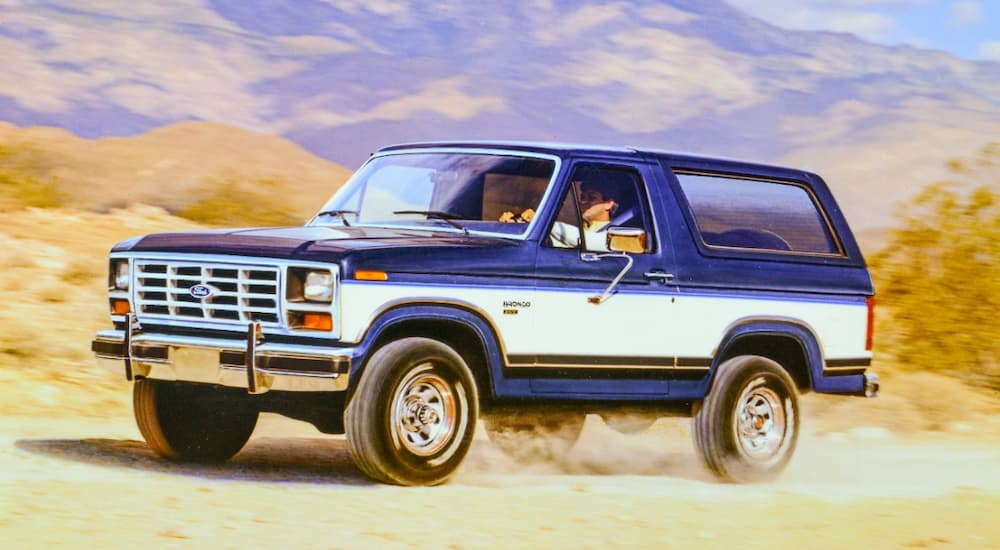
Bred by Baja
If the race sounds like something of an endurance test, that’s because it is. In fact, initially, it wasn’t a race at all but something closer to a manufacturer’s proving ground. While the first official race occurred in 1967, the Baja 1000’s history began four years earlier when motorcycle racer and Hollywood stuntman Bud Ekins was tapped by Honda to test out the new CL72 Scrambler motorcycle. Ekins drafted his brother and a local Honda dealer into the escapade, and the trio made for the desert with the stuntman personally selecting the 950-mile route from Tijuana to La Paz. The team came in just under the wire, braving shifting sands and empty gas cans to beat their stated goal of 40 hours by a scant four minutes, and the rest is automotive history.
The escapade caught the attention of gearheads across the country, leading to the formation of NORRA (National Off-Road Racing Association) and the first running of what was initially called the Mexican 1000 in 1967. The event continued for years, gaining more participants and media attention until the oil crisis of the early ’70s led to its abrupt cancellation – and the disbanding of NORRA – in 1974. The uniquely grueling race had won some diehard fans in both the racing scene and local Baja government, and the hiatus wouldn’t last long. The government-backed Baja Sports Committee teamed up with SCORE (Southern California Off-Road Enterprises), operated by seasoned off-road racing promoter Mickey Thompson. By 1975 the race was back on and has since grown to include over 40 distinct classes of vehicles. Motorcycles are present, of course, but the desert race now accommodates everything from quad bikes and buggies to Jeeps, trophy trucks, and open-wheel Class 1 vehicles purpose-built for the event.
The Bronco itself is an inescapable part of Baja history. The 4×4 wasn’t just the first production vehicle to win the race – it immediately announced itself as a perennial contender, taking home the crown in 1969, ‘71, and ‘72. Souped-up VWs would dominate the race for much of the ’70s and ’80s, but Ford retained its relevance, making a big comeback in the early ’90s with a few dominant pickup and trophy truck winners. This would continue well into the 2000s, with Ford trading the title with Chevrolet for the better part of 20 years.
In 2011 a familiar name popped up as a Ford Raptor trophy truck piloted by Andy and Scott McMillin won the event. Conceived as an off-road-ready version of the brand’s enormously popular F-150 pickup and boasting a 6.2-liter V8 with 500 horsepower, the SVT Raptor R had everything it takes to be the alpha predator of the Baja desert. The reintroduction of the Bronco in 2020 gave Ford the perfect excuse to head back to Baja, with the 2.7-liter EcoBoost Bronco R Race Prototype completing the race in just over 32 hours. The race not only provided the perfect opportunity to showcase the modern Bronco but also allowed Ford the opportunity to put the finishing touches on the production model’s Terrain Management System. Drivers can select between a number of driving modes purpose-built for varying conditions, including, of course, Baja Mode.
Now the Bronco Raptor is getting ready for its turn at the famous rally. While details are scant on some of the specifics around the 2023 model, Ford has set itself quite the task is trying to live up to both the Bronco and Raptor names. The early specs look promising, with massive 35-inch wheels equipped with Bilstein dampers – 37” if you spring for the BFGoodrich K02 All-Terrain tires – as well as the Fox Live Wire adaptive dampers found on the F-150 Raptor. The Bronco Raptor is built slightly wider than the base Bronco: so wide, in fact, that it’s legally required to include the amber lights reserved for vehicles over 80 inches. Spy shots have picked out what look to be larger axles and rear anti-roll bars, giving the Bronco Raptor the heavy-duty hardware necessary to tackle the desert marathon. Under the hood, the Bronco Raptor is expected to feature a twin-turbocharged 3.5-liter V6 lifted out of the F-150 Raptor, producing 450 hp and as much as 510-pound-feet of torque; a considerable upgrade over the base Bronco’s 310-hp, 2.7-liter setup.
Worth the Wait
Drivers will have to wait until 2022 to get behind the wheel of the new Bronco Raptor, but we certainly can’t wait to see what this vehicle is going to do once it is able to hit the pavement. The current looks we’ve gotten at the model are promising, and if Ford can deliver a model that meets the expectations of fans like they did with the original Bronco release, then this model is sure to be every off-road enthusiast’s next buy.

